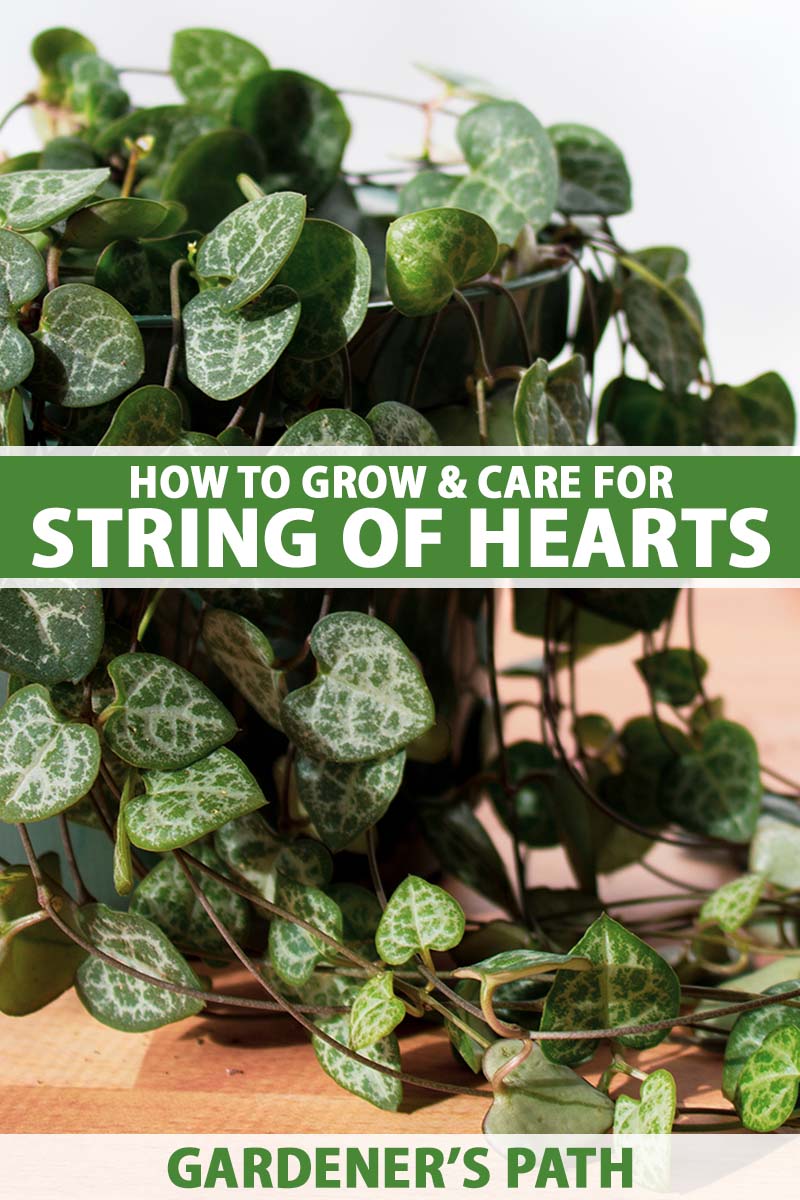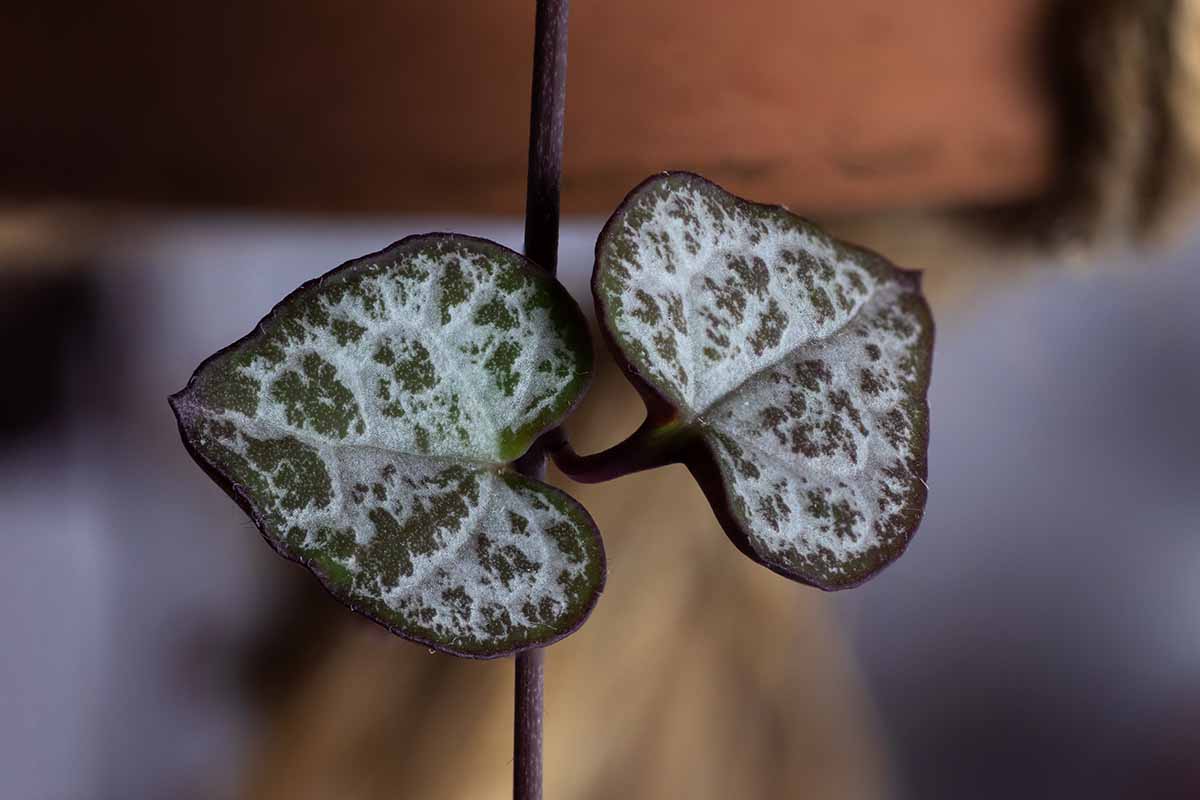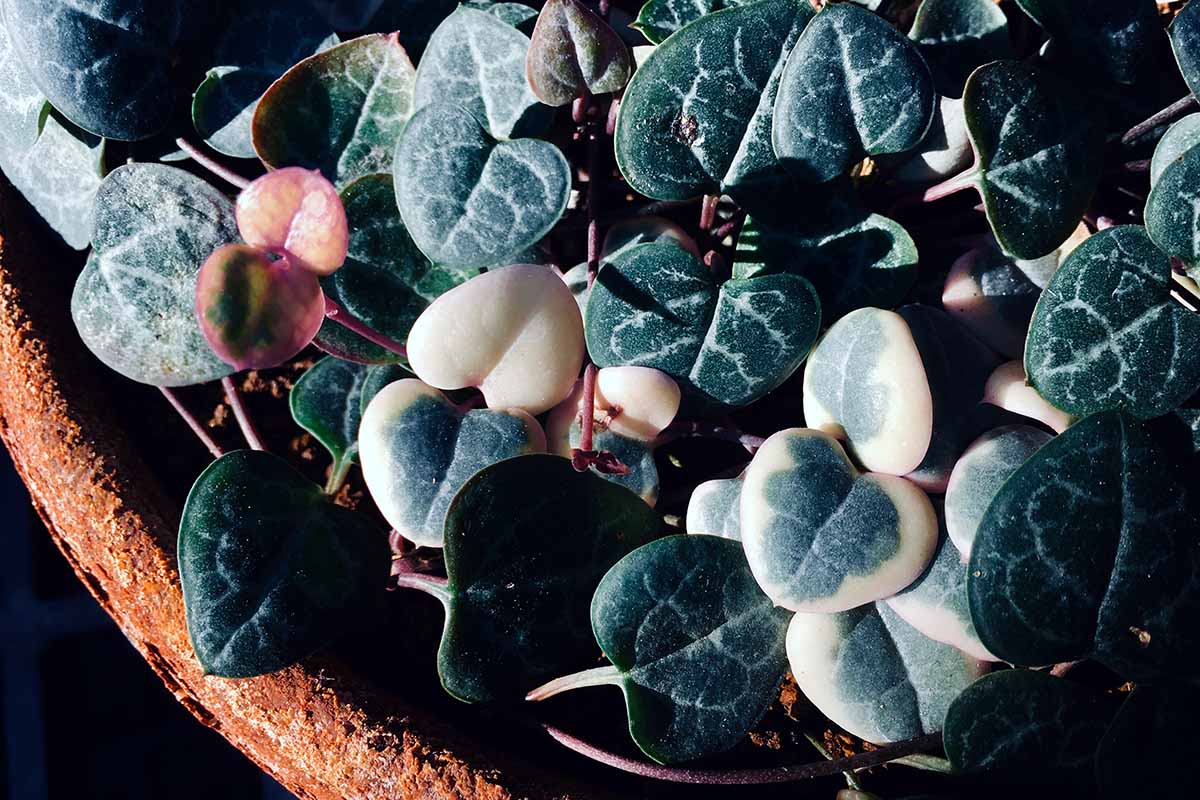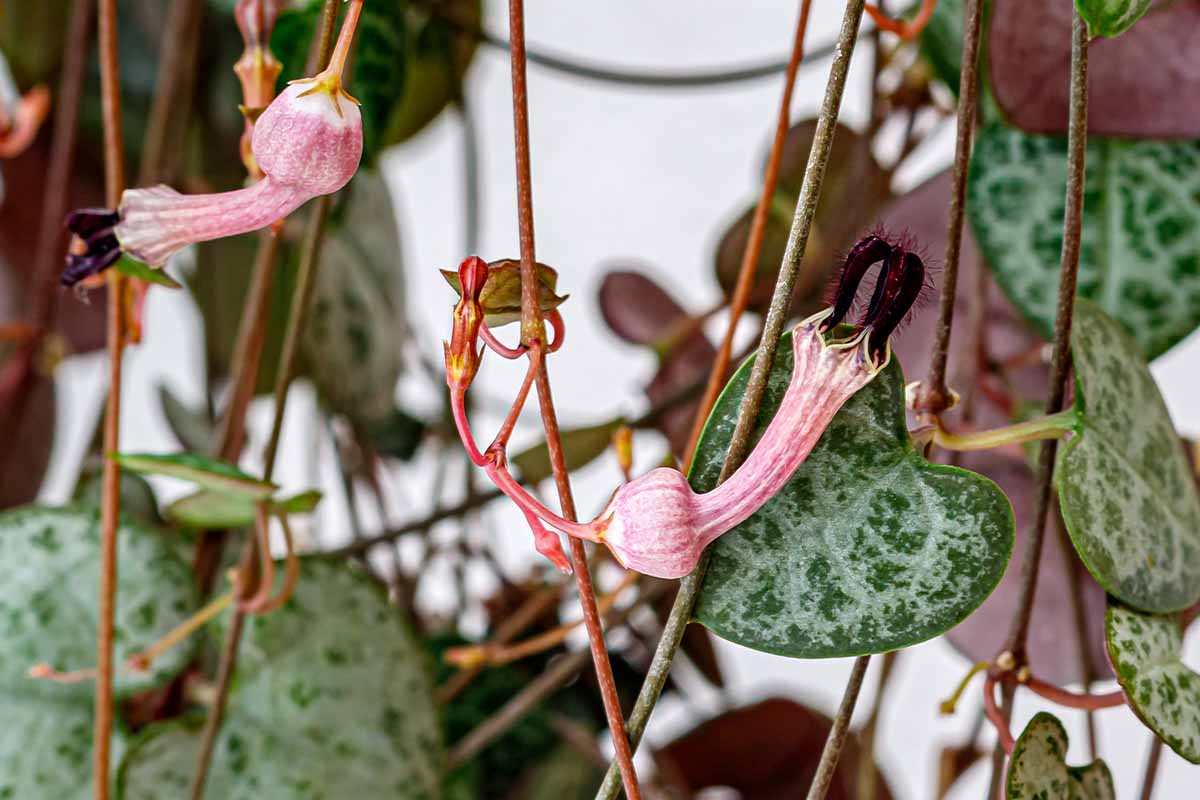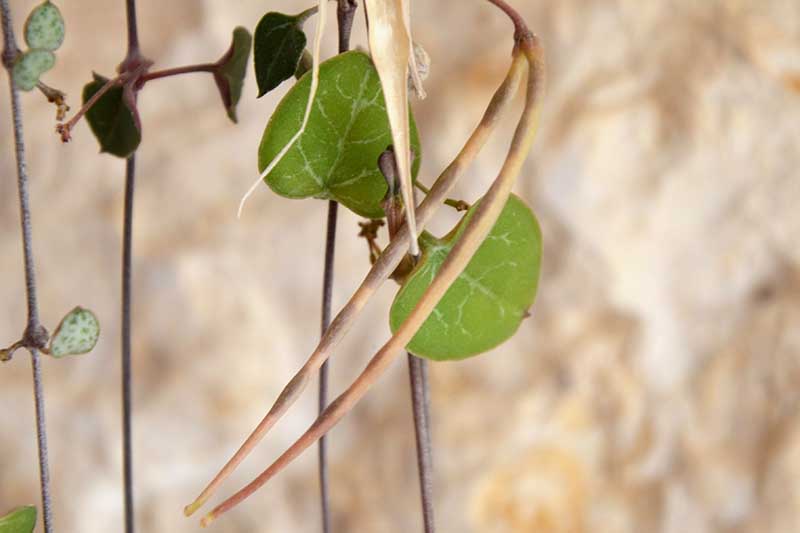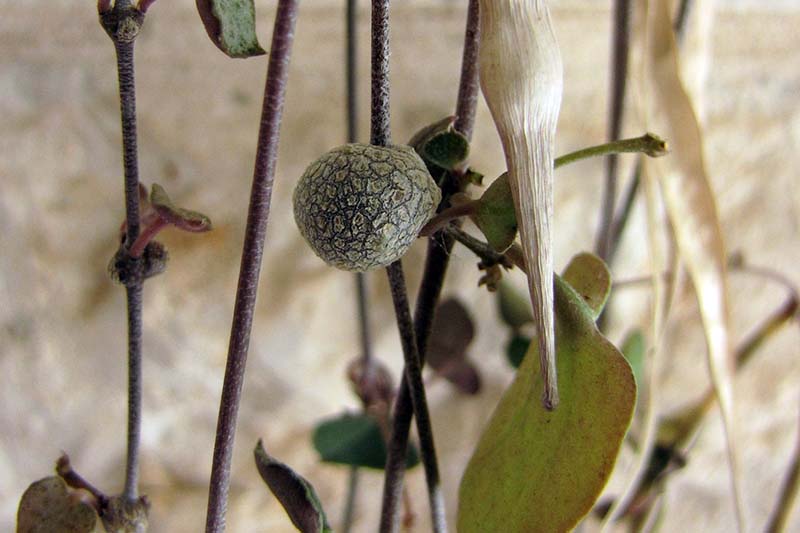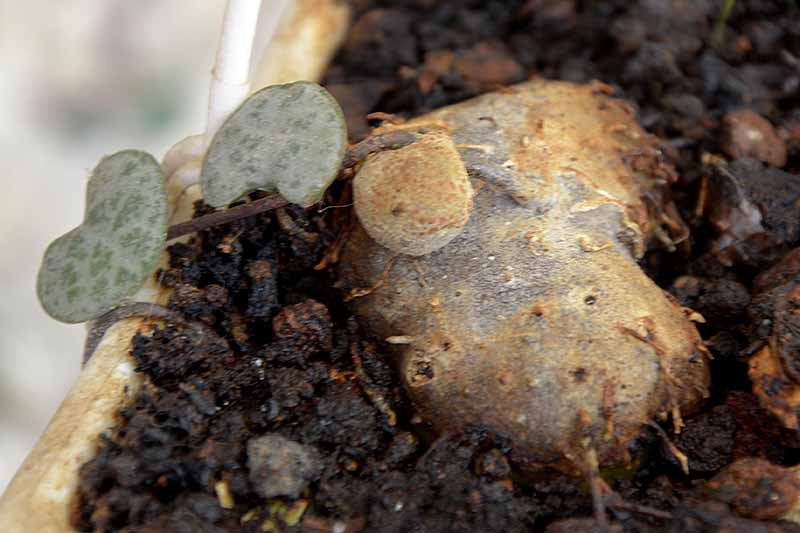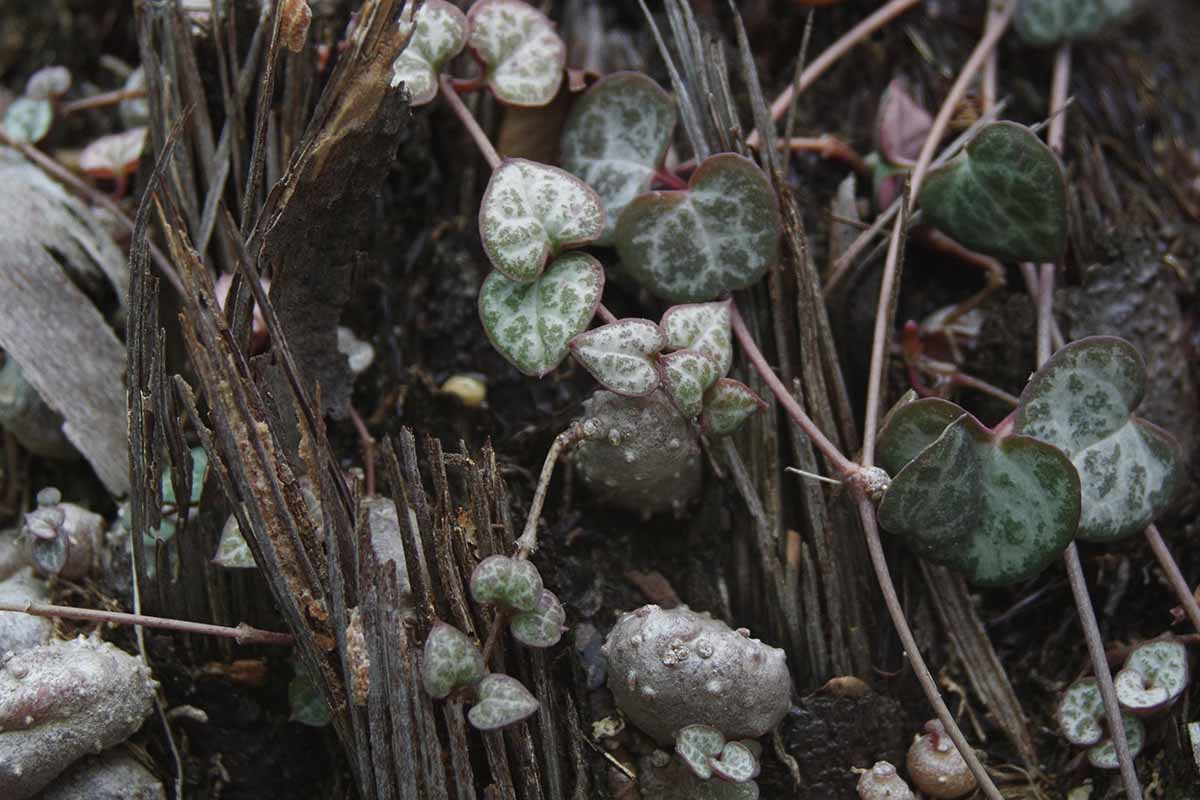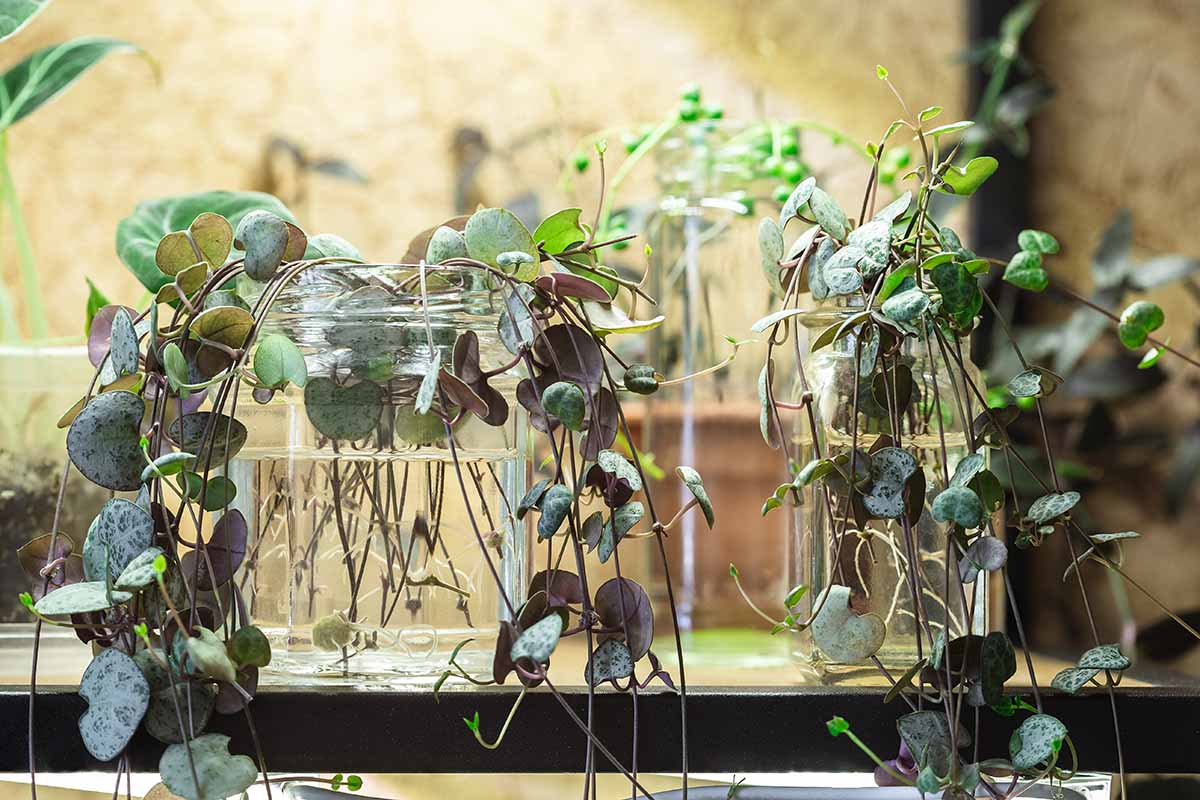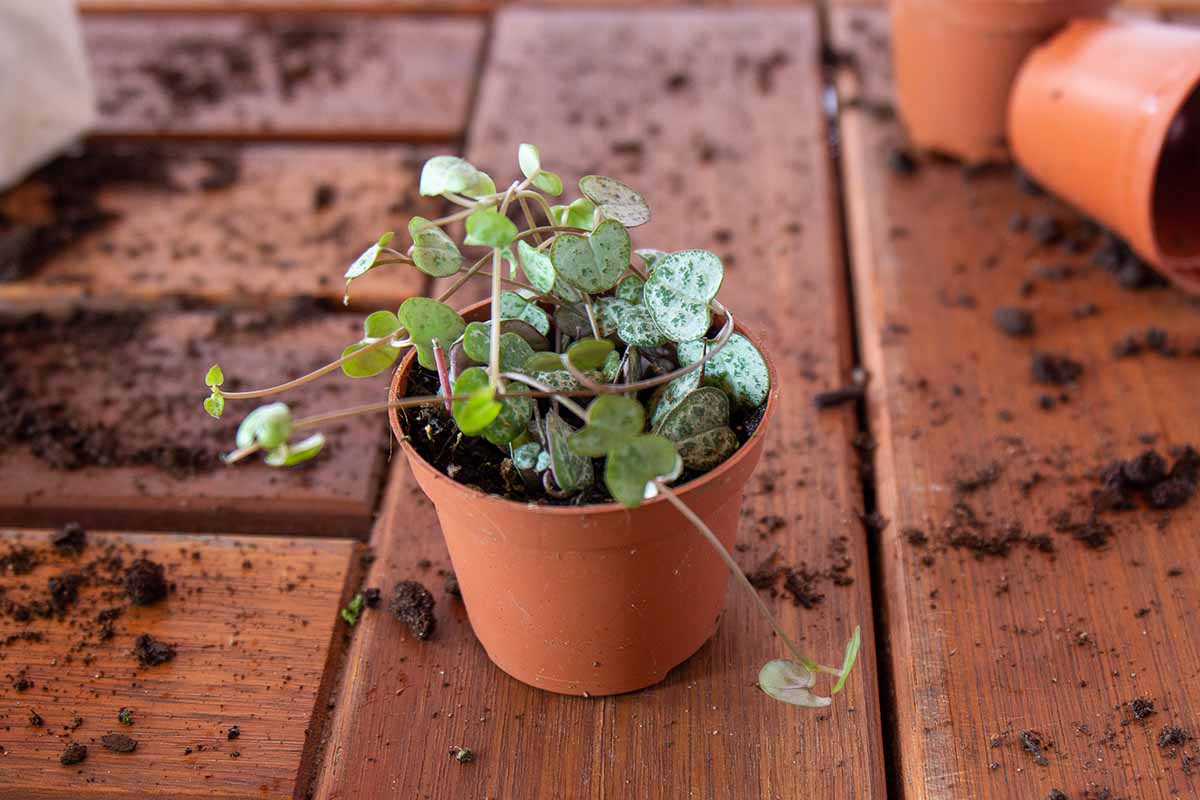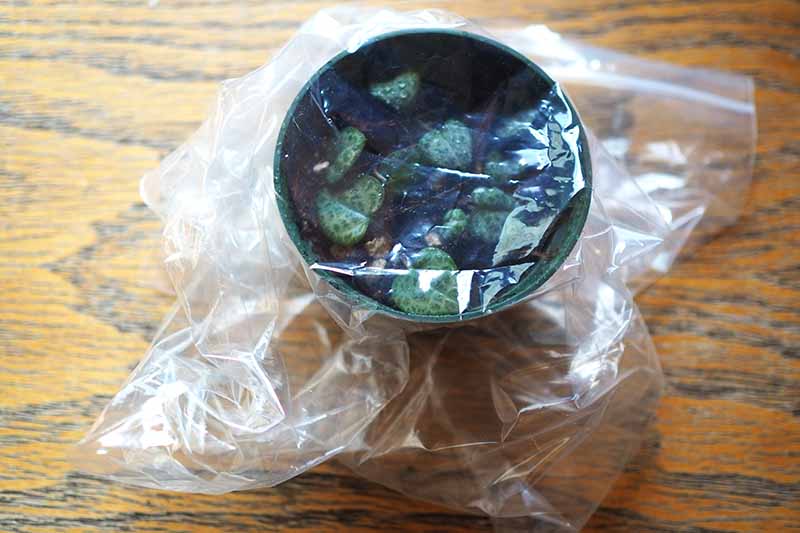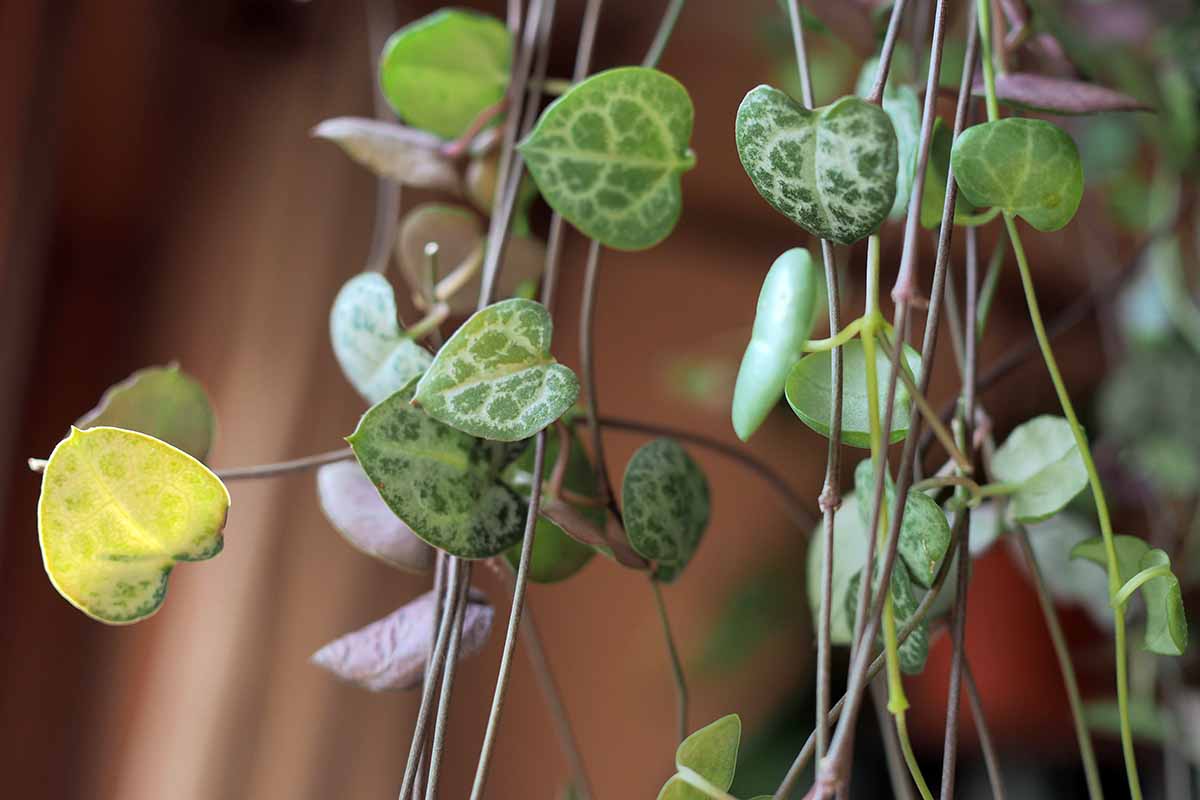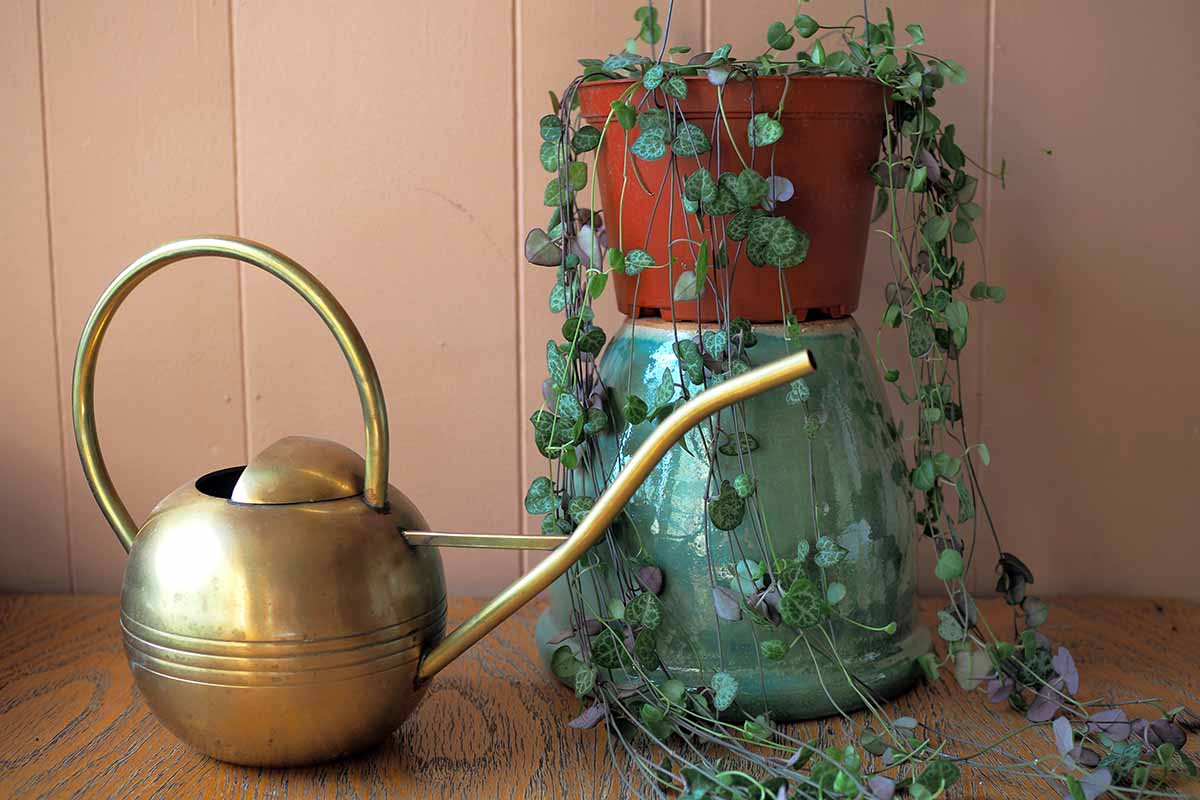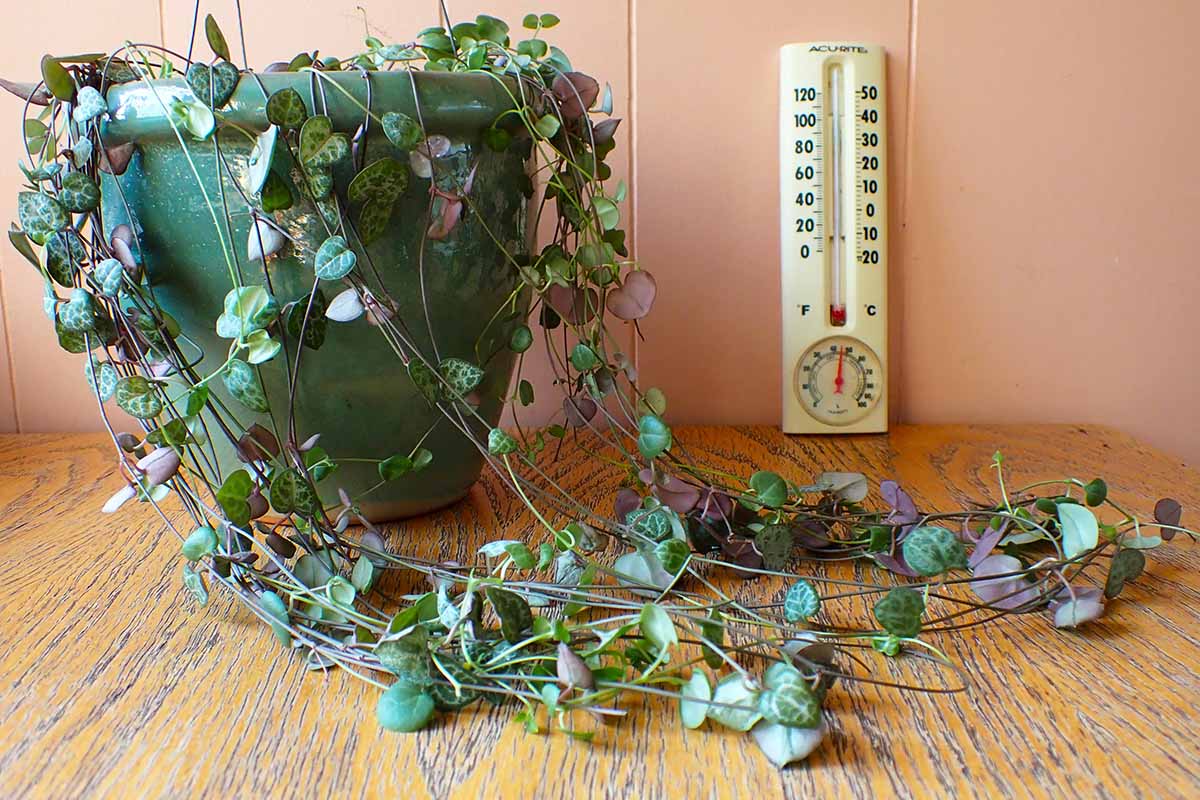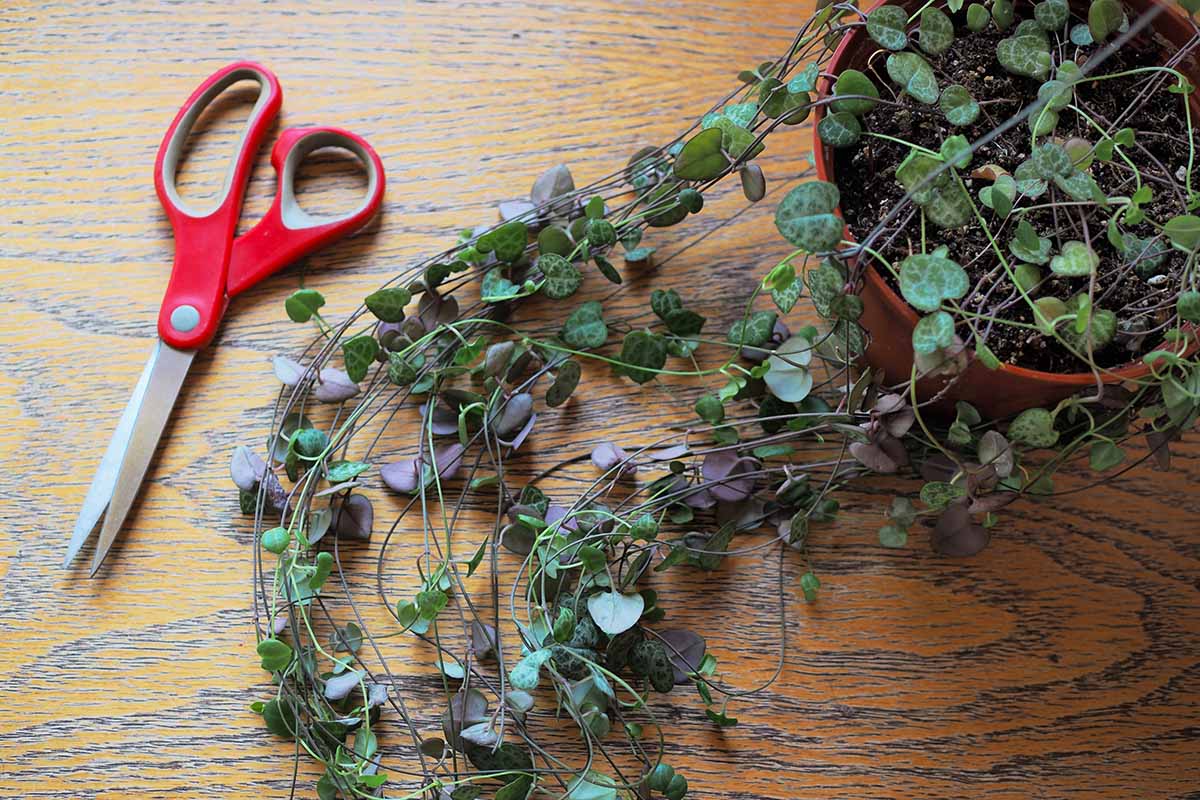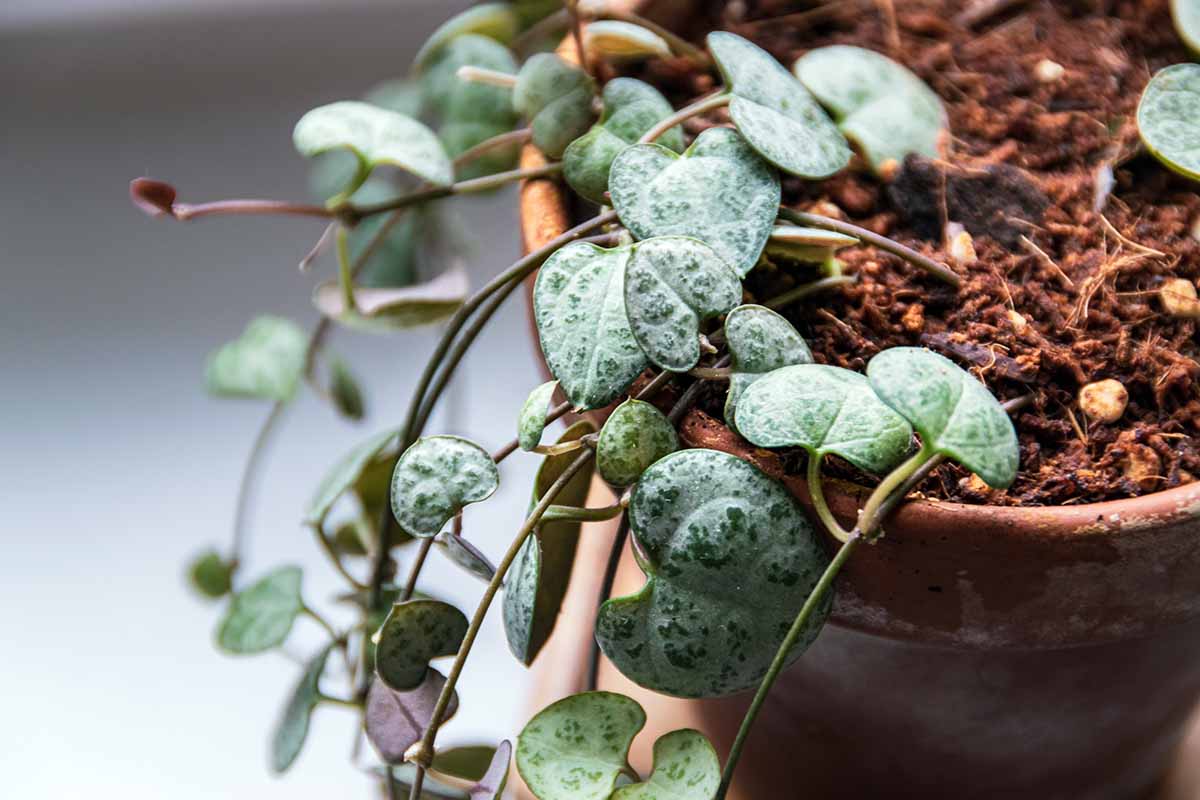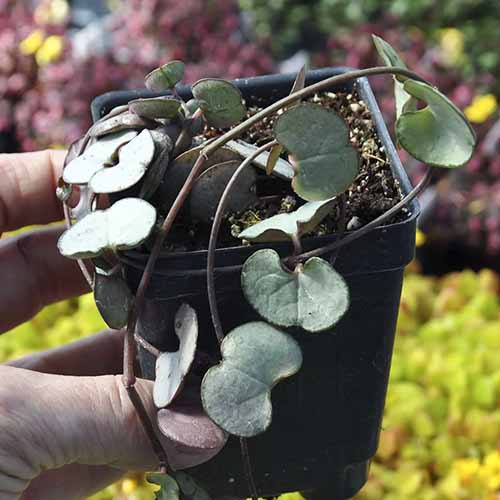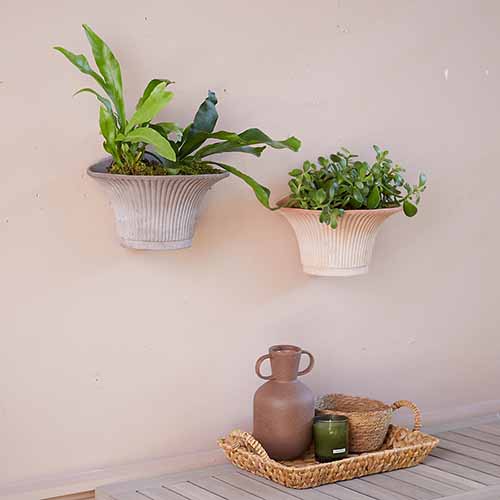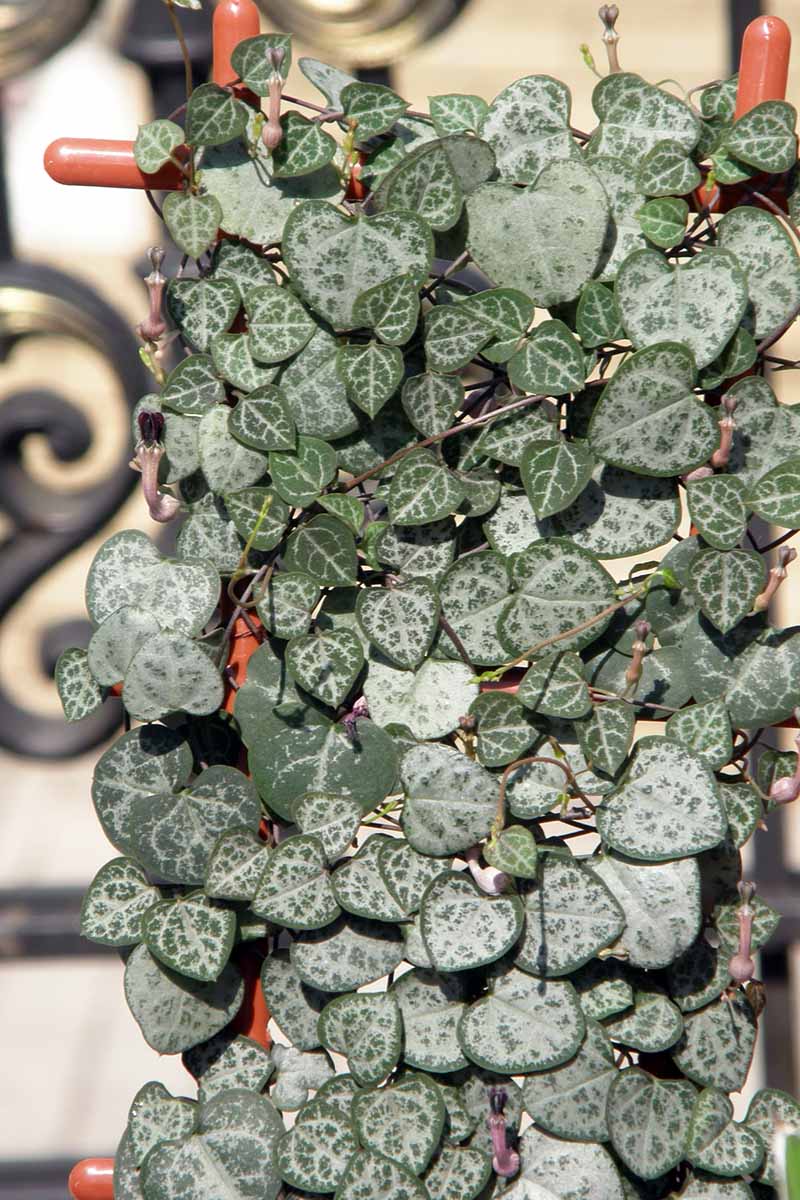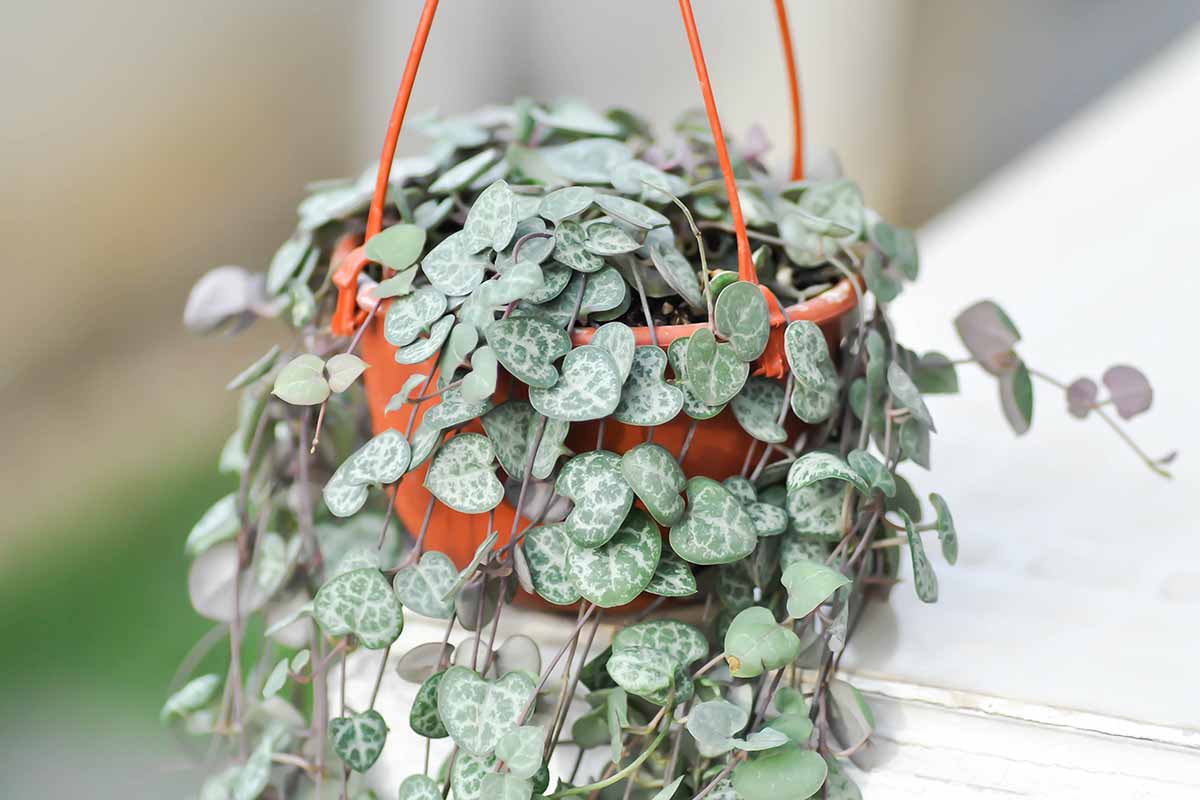We link to vendors to help you find relevant products. If you buy from one of our links, we may earn a commission. Here’s a peek at where this tale will take us:
What Is String of Hearts?
String of hearts (Ceropegia woodii) is an evergreen perennial that grows long, climbing and trailing vines covered with small, succulent, heart-shaped leaves. The fleshy leaves of this plant, which is also known as rosary vine, are oppositely arranged on vines that have long internodes – leaving much of the wiry-looking stem visible. The top sides of this species’ leaves are dark green with silver veining or mottling, and look quite similar to the leaves of cyclamens, though leaf color can vary somewhat from plant to plant. The bottom sides of these leaves add visual interest, as they are light grayish green to purple in color. In the wild, string of hearts vines can grow up to 13 feet long – and when grown indoors they can reach impressive lengths as well. Rosary vine bears small, mauve and purple, lantern-shaped flowers that are waxy, with a bulbous base and five fused petals that create small windows where pollinators can enter. However, here the tale takes a seemingly ominous turn: string of hearts’ odd-looking flowers act as a pollinator trap. Small flies are attracted into the flower and can’t escape. Until, that is, the downward-pointing hairs lining the inside of the flower wither, at which point the insects are (hopefully) well-loaded with pollen, and ready to move on to the next flower. See, string of hearts isn’t good-looking but vicious after all! The trap was only temporary. These fascinating instances of pollination take place in summer or autumn when plants live outdoors full time, but houseplants may bloom sporadically throughout the year. If the little captive flies do their duty and the flowers are pollinated, blooms will be replaced by long, thin seed pods which split when dry, revealing seeds attached to fluffy tufts, ready to be dispersed by the wind, much like the seeds of dandelions. But seed dispersal is not the only way string of hearts plants reproduce – these vines can produce air tubers as well. The tubers look like tiny potatoes and appear at nodes on the vines, and are likely the inspiration for the common name “rosary vine,” since they give the appearance of beads. These tubers can take root in the soil, eventually growing to form a caudex, which is a type of woody stem. Caudices store water for string of hearts plants, and they can reach up to four inches wide.
Cultivation and History
C. woodii is native to southern Africa, and its range includes Eswatini, South Africa, Mozambique, and Zimbabwe. In its native range, string of hearts grows in thin, rocky or sandy soils, often growing on cliff ledges and rocky outcrops, or climbing up through bushes. C. woodii is a member of the dogbane family (Apocynaceae), counting among its relatives oleander, plumeria, milkweed, and hoya species. String of hearts is the most well-known member of its genus, Ceropegia, though other members of this taxonomical grouping are also grown as houseplants, including lantern flower (C. haygarthii). The melodious genus name Ceropegia is Greek for “wax fountain,” referring to the unique appearance of the flowers of this genus. Rosary vine’s species name woodii honors a South African botanist by the name of John Medley Wood, curator of the Durban Botanic Gardens from 1882 until 1913. This species has a multitude of common names, including “hearts on a string,” “chain of hearts,” “collar of hearts,” “sweetheart vine,” “heart vine,” “hanging milkwort,” and “necklace vine.” Its moniker “hearts entangled” gives one a good idea of what easily happens to the plant’s long vines! Speaking of names, in addition to its accepted classification as C. woodii, this species is sometimes classified as C. linearis subsp. woodii, which is considered a synonym. Rosary vine also has a history of non-ornamental use. In its native range, the small tubers of C. woodii are treated as a survival food, and the plant has also been used as an emetic in traditional Zulu medicine. This species, a recipient of the Royal Horticultural Society’s Award of Garden Merit in 1993, can be grown outdoors year-round in USDA Hardiness Zones 10 to 12.
Propagation
There are many different ways string of hearts plants can be propagated: from seed, from air tubers, from cuttings, or through layering. However you choose to propagate this species, you are most likely to be successful if you do so during the plant’s active growth period in spring or summer.
From Seed
Although this is not the fastest propagation method, string of hearts can be grown from seed. For this gardening project you’ll need a seed-starting medium, small nursery pots or a tray, a humidity dome or transparent plastic bags, a spray bottle, and some rosary vine seeds. Be aware, though, that it can be hard to find rosary vine seeds for purchase. If you find seeds for cultivated varieties, they may not sow true to type. Once you have all your supplies, fill the tray or nursery pots with a sterile seed-starting medium. Wet the soil down with the spray bottle, then firm the soil by pressing on it lightly.
From Cuttings
Chain of hearts cuttings can be rooted in water, which is a good technique to use if you accidentally break off a vine and don’t have time to pot it up, or if you just enjoy watching the plant’s roots develop in water. Cover the tray with a humidity dome or place each nursery pot inside a plastic bag to keep humidity in. Jump Start Heat Mat Keep the germinating string of hearts seeds moist but not soggy – watering with a spray bottle will help to prevent waterlogging the soil. You should expect germination in one to four weeks. Once seeds have germinated and seedlings start to produce leaves, you can gradually reduce their humidity and start to water normally, as indicated in the watering section coming up later in the article. Take cuttings with at least two or three nodes – that’s to say, two or three pairs of leaves. This will allow for enough vine to hang both into the water and over the rim of the jar. Cut the leaves off the bottom node, and stick this part of the vine into the jar so it’s submerged under water. Repeat with as many cuttings as you’d like. As the cuttings take root, make sure to keep the water in the jar topped off and change it out if it starts to look cloudy or dirty. Keep the cuttings in indirect, bright light. Once the string of hearts cuttings develop roots, you can remove them from the jar and plant them in soil. Start with a four-inch pot and plant cuttings about an inch apart in a suitable medium, such as succulent and cacti mix. Take cuttings from a vine and cut them into small sections with one set of leaves and about an inch of stem on either end of the node. This is often called the “butterfly method” because of the shape of the cuttings. In addition to cuttings, here’s everything else you will need for this project: a pair of scissors or garden snips, a tray or nursery pots, growing medium, and a humidity dome or resealable plastic baggie. To help with planning when you’re procuring your pots, a four-inch nursery pot will work nicely for about five cuttings. You may also want rooting hormone for better rates of success in rooting cuttings, such as Olivia’s cloning gel, available in two-, four-, or eight-ounce jars from Arbico Organics. Olivia’s Cloning Gel in 2-, 4-, or 8-oz Pots Before taking your cuttings, go ahead and get your pots ready. Fill the nursery pots or tray with succulent growing medium, leaving about an inch of space between the surface of the soil and the rim of the pot. Cuttings taken from mature vines are a good choice for rooting in soil – look for those with thick, fleshy leaves. Those with aerial roots also make an excellent selection. You can use longer cuttings if you prefer, but this method maximizes the number of specimens you can produce from your propagation material. Next, dip both cut ends of the stems into rooting hormone if you’re using it. Lay out the cuttings onto the soil horizontally, leaving the leaves above the soil and covering both cut ends with a light layer of growing medium. Space the cuttings an inch or so apart, placing five cuttings in each four-inch pot. Cover each pot with a plastic baggie to keep in humidity, then place in indirect, bright light. Your cuttings should root in 14 to 20 days. Once cuttings start to produce new growth, you can gradually decrease their humidity by opening the plastic bags more and more, until you eventually remove them entirely.
From Air Tubers
When your rosary vine is producing air tubers, this offers yet another way of propagating your plant. As with cuttings, choose about five tubers for each four-inch pot. Fill the pot with succulent mix, leaving about an inch of room between the soil surface and the rim of the pot. Bury each tuber halfway in the soil, so half emerges above the soil line. Use a spray bottle to water the soil so it’s moist but not soggy. Cover the pots with a plastic bag to hold in humidity, then place these specimens in indirect bright light and keep moist until fully rooted. As with the other propagation methods, you can begin to remove the bag once the tubers are rooted and showing new growth. Air tubers can also be propagated while they’re still on the parent plant through a technique called “layering.” Keep reading to learn more.
From Layering
Sweetheart vine can also be propagated via layering, a technique where stems are laid across soil while they’re still attached to the parent plant.
How to Grow
Here’s all you need to know when it comes to growing this plant: Packs of 160 U-Shaped Floral Pins Mist the soil to help the vines take root, and keep it moist but not soggy. Allow the vines to take root before severing them from the parent plant. This may take up to four weeks.
Light
Chain of hearts is fairly adaptable when it comes to light – however, if you want the best possible color from your plant’s foliage, provide it with bright indirect light and up to four hours of direct sun each day. In lower light, leaves will be lighter green with less distinct variegation. Plants will also become etiolated, with longer spaces between nodes as the stems are trying to reach towards the light, so watch for these signs that your plant is feeling a little hungry for more sun!
Water
Allow the top two inches of string of hearts’ soil to dry out between watering. For me, this means watering approximately once a week during the summer. Conditions in your home may be different though, so adapt your schedule as needed. In winter, when days are shorter and cooler, you may need to reduce watering frequency. If the leaves of your plant start to feel mushy, that’s a sign you are overwatering. If the foliage at the top of your plant’s pot is quite dense, use a well-adapted houseplant watering can for this task, so you can aim the water directly at the soil without sprinkling the foliage. You can find a selection of some of the best watering cans for houseplant care in our article.
Soil
Rosary vine is a succulent that requires a well-drained but rich growing medium, with a soil pH of 6.1 to 7.5. On the other end of its tolerance range, as a tender perennial, this plant will be killed by freezing temperatures and can be damaged by frost. So if you hang your specimen outdoors for the summer, make sure to bring it back in before the frosty weather arrives. Tank’s Pro Cactus and Succulent Mix contains chunky coconut coir, horticultural pumice, and organic compost. Tank’s Pro Cactus and Succulent Mix
Climatic Conditions
C. woodii thrives in mild temperatures, in a range between 60 and 85°F. Plants will tolerate warmer temperatures, but they may need more frequent watering and less direct sunlight. As far as humidity goes, this plant grows well in average household humidity and doesn’t require misting or other humidification efforts.
Growing Tips
Grow in indirect, bright light with up to 4 hours of direct sunlight.Grow in a well-draining potting medium intended for cacti and succulents.Allow the top two inches of growing medium to dry between watering.
Maintenance
Like any long locks, the vines of your string of hearts may require a bit of upkeep from time to time. Here are some tips for long-term maintenance:
Pruning
You may want to prune your string of hearts for a few different reasons: to keep its vines at a manageable length, to encourage branching, or for propagation. Also, if your rosary vine is living up to its nickname “hearts entangled,” pruning is sometimes the easiest way to get rid of a snarl. Sometimes trying to detangle these vines results in a lot of foliage falling off, since these leaves act like hooks, snagging on to other vines. Trimmings can be used to start new specimens or can even be rooted back into the same pot to create a fuller houseplant. Whatever your reason for pruning, be sure to sterilize your scissors or snips prior to making any cuts.
Repotting
When it’s time to repot your specimen, choose a pot that is just one size larger than the current pot. This is imperative for avoiding root rot, since oversized containers can cause plant roots to sit in soggy soil for extended periods of time. While these succulents can be grown in small hanging baskets, if you want really long vines, keep repotting in larger containers as needed – as their roots grow, they will need more room to keep producing longer vines. A good repotting schedule for string of hearts is about once every two or three years, and you should plan to repot in the spring or early summer when plants are actively growing. For this project you’ll need succulent growing medium, and a pot that is just one size larger than the plant’s current container. (Yes, this is a reminder in case you didn’t notice when I said it a few sentences ago!) If your specimen is in a hanging basket, start by removing the hanger. Next, get the new pot ready – place a small amount of fresh growing medium in the bottom of the pot. Turn the plant sideways and gently ease it out of its container, taking care not to pull it by its vines. Instead squeeze the pot if necessary to help remove the root ball. Before moving the rosary vine into its new pot, rub the palm of your hand along the root ball to loosen up the roots. If some of the old growing medium is released during this process, mix it with some of the new growing medium to ease the transition. Situate the rosary vine in its new pot, adding more or taking away soil as needed in order to leave an inch of space between the soil surface and pot rim, then backfill with growing medium. Water in your specimen and return it to its usual location.
Managing Pests and Disease
As a low-maintenance houseplant, chain of hearts isn’t particularly vulnerable to pests or diseases. Dr. Earth’s Succulence Cactus and Succulent Food You’ll find Dr. Earth’s Succulence Cactus and Succulent Food in a convenient 16-ounce pump bottle from Dr. Earth via Arbico Organics. Follow the manufacturer’s instructions for applying this product, and fertilize no more than once a month, only during the growing season.
Cultivars to Select
Whether you choose the straight species or a cultivated variety, there are some exciting options when selecting a rosary vine:
String of Hearts
C. woodii, the straight species, has dark green, heart-shaped leaves with silver veining and mottling. The backs of the leaves are light green to grayish-lavender in color. Live String of Hearts Plant in 4” or 6” Pot
Pink Edge
‘Pink Edge’ is a variegated rosary vine whose new leaves come in with pink leaf margins, which mature to a creamy white. This cultivar, also known as ‘Pearl Moon,’ is a much slower grower than the straight species. Live Pink Edge Plant in 2.5” Pot A live ‘Pink Edge’ plant can be purchased in a two-and-a-half-inch pot from Hirt’s Gardens via Walmart.
Silver Glory
A silver color dominates with the rosary vine cultivar known as ‘Silver Glory.’ The leaves of this selection are mostly silver, with dark green margins and a bit of dark green mottling on the top surface of the leaf. The bottom sides of these dazzling leaves are lavender-colored. Live Silver Glory Plant in 3” Pot Did the sight of this option make you feel like you struck – not gold, but silver? You’ll find a live ‘Silver Glory’ plant in a three-inch pot from Winter Greenhouse via Walmart. Discover more string of heart cultivars in our roundup. (coming soon!) However, even the sturdiest houseplant can sometimes fall victim to some common problems. Watch out for mealybugs and scale insects, particularly on newly purchased specimens. These sucking insects steal nutrients from stems and foliage, weakening them and eventually killing the plant. Likewise, aphids are another potential problem. All three of these pests can leave trails of sticky honeydew behind, potentially allowing fungal pathogens to proliferate on plants in addition to the damage done via nutrient depletion. If your plant’s foliage is wilting yet its soil is wet – behold! The dreaded root rot may have struck once again. If you frequently indulge your flights of houseplant fancy by acquiring new specimens, it’s a good idea to keep a bottle of neem oil on hand just in case, such as Theraneem 100% Neem Oil. Theraneem Neem Oil in 16-Oz Bottle Be sure to follow the manufacturer’s instructions when applying this product – it needs to be diluted. In addition to keeping an eye out for aphids, mealybugs, and scale, the main disease you should be on watch for is root rot. This disease occurs when plants are allowed to remain in a soggy growing medium. This causes roots to decay and allows pathogens to flourish. If your specimen’s pot lacks drainage, its soil is not well-draining, or it has been allowed to sit in a saucer of water, root rot can quickly sicken the plant. And believe me when I tell you it can only take one time forgetting to empty a saucer for conditions to take a bad turn! Overly frequent watering can also be to blame, so make sure to follow the watering recommendations mentioned earlier in this article. Helping a houseplant recover from root rot isn’t always successful, so prevention is the best strategy. However, if you suspect this problem, you can try to save your rosary vine by removing it from its growing medium, trimming any decaying roots, and repotting it in fresh growing medium in a sterilized (or new) pot. If there are any healthy-looking vines left, it’s a good idea to propagate some of them as backups as well. If your home happens to have really tall ceilings, this plant will really be able to show off, as its vines can grow prodigiously. On the other hand, if suspending a basket from your ceiling isn’t practical, don’t worry, you still have options! Fluted Gray Terra Cotta Wall Pot 7” x 12” Rosary vine can also be grown in a wall sconce type planter, such as this fluted, gray terra cotta wall pot, available from Terrain. Although allowing chain of hearts vines to trail down seems like the obvious choice, it’s not the only possibility. This houseplant’s vines can also be trained to grow upwards on a topiary frame or a trellis. For outdoor plantings in USDA Hardiness Zones 10 to 12, string of hearts can also be allowed to spill over stone ledges in rock gardens. Finally, for households with young kids or curious pets, this plant is considered nontoxic and is safe to grow and display.
Quick Reference Growing Guide
Rapunzel, Rapunzel, Let Your Vines Grow!
As we would expect, this fairy tale should have a happy ending too, now that you know just how to keep your string of hearts happy and healthy. Do you have any tips of your own for growing rosary vine? Need help troubleshooting care for this succulent? Let us know in the comments! And if you are interested in other vining or trailing succulents that work perfectly in hanging baskets, read these guides next:
How to Grow and Care for Donkey’s Tail SucculentsHow to Grow and Care for String of PearlsHow to Grow and Care for Christmas Cactus
